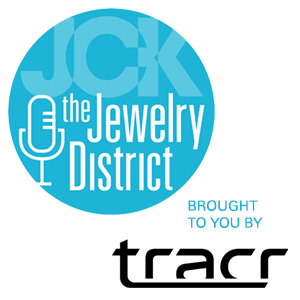
On this week’s episode, JCK editor-in-chief Victoria Gomelsky and news director Rob Bates discuss Victoria’s recent trip to the Treasure State, where she got a close-up view of Montana sapphire mining, courtesy of Parlé—and had the chance to do a bit of sifting for gemstones on her own. Rob brings listeners up to speed on consolidation news in the lab-grown diamond sector and offers insights into what it means for the market’s future. Bonus: Don’t miss JCK’s first-ever digital issue, available Sept. 16.
Listen Now:
Sponsored by Tracr: tracr.com
Episode Credits
Hosts: Rob Bates and Victoria Gomelsky
Producer and engineer: Natalie Chomet
Editor: Riley McCaskill
Plugs: @jckmagazine; tracr.com
Show Notes
04:16 JCK introduces digital magazine
05:07 Victoria mines for sapphires in Montana
16:50 Rightsizing in the lab-grown diamond market
Show Recap
JCK introduces digital magazine
Victoria announces that JCK will publish its first-ever digital magazine on Sept. 16. The publication will look like a regular (print) issue but will be accessible exclusively online as a flip-book. Consider it a holiday survival guide, says Victoria. Look for lots of information on current trends, along with tips for optimizing the holiday sales season.
Victoria mines for sapphires in Montana
The conversation turns to Victoria’s recent trip to Montana with Idaho-based jewelry design company Parlé. Founded in 1973 with a focus on pieces featuring Idaho opals, the brand has expanded and diversified over the years, first into Australian opals and then into Montana sapphires—and has won a number of Jewelers’ Choice Awards for its designs featuring colorful gemstones.
Victoria joined about two dozen Parlé retailers to learn about Montana sapphires, which have been catching on with designers. These sapphires are known for their small size and cornflower blue color.
The Parlé group visited Rock Creek, a small town within a remote stretch of Montana just over an hour southeast of Missoula that is home to the largest sapphire deposit in the Western Hemisphere. Like Montanta’s Yogo Gulch, it was discovered in the 19th century.
Rob asks how the mine, now overseen by Canadian company Potentate Mining, compares to others Victoria has visited. “It’s closer to the artisanal end than Jwaneng in Botswana,” she explains. Rather than mining a massive open pit, mechanized equipment removes large chunks of earth and breaks down boulders so that finer machinery can shake and sift smaller pockets of deposit material to reveal gemstones.
Victoria took part in a sip-and-sift event, where she and her fellow Parlé guests were each given a bag of rocks and a sifting screen to shake under a water-powered sluice. Because sapphires have a higher density than most other rocks, when you flip the tray over, there’s a good chance you’ll find them on top, she explains.
Rob asks if she found any sapphires. “Yes!” she says, though she suspects every bag was salted with a few of the “tiny little faded blue, vaguely translucent rocks.” Victoria used hers in a pendant for her son.
It was a fun experience, ideal for a group event like a bachelorette party, says Victoria. “You get to hang out in beautiful Montana, sip wine, and sift through rocks for sapphires.” (Visitors can take part in mining experiences like this one through Gem Mountain.)
One of the most compelling aspects of Vic’s sip-and-sift experience was the realization that she was replicating (albeit on a smaller scale) the methods Potentate’s machines use to sift and shake deposit material. She was also struck by the speed and dexterity of workers sifting through the gems at the sorting facility she visited the following day. “It is amazing what it takes to find these tiny little treasures,” Victoria says.
Rightsizing in the lab-grown diamond market
Next up for discussion: news in lab-grown diamonds. Is the industry rightsizing? Some signs point to yes. Lab-grown e-tailer Grown Brilliance just purchased competitor Clean Origin as well as Aether Diamonds, which specializes in capturing carbon from the sky. Equally notable is the fact that in past 12 months both WD Lab Grown Diamonds and Diam Concept liquidated. Meanwhile, Israeli grower Lusix is facing financial problems.
It’s significant that all these businesses were diamond growers (except for Clean Origin), but none were based in India or China, where a lot of growing takes place. Rob also draws listeners’ attention to the fact that all the companies in question attracted investment from the trade and/or private equity. That’s relatively unusual in diamonds and jewelry and shows that the “disruptive” lab-grown diamond story is attractive to investors, he says.
Rob sees these moves as part of a shift toward vertical integration in the lab-grown sector. “I think the larger trend you’re going to see is growers selling direct to consumers,” he says. The wave of consolidations was predictable, in his opinion. When a new trend hits an industry, “everybody jumps on the bandwagon, and not everybody makes it,” Rob notes .
Victoria asks about Aether, known for its carbon-capture technology. Rob says Aether found it difficult to compete amid a flooded market and low prices by India growers but will continue to produce diamonds on demand for Grown Brilliance. He notes that Aether’s founder has a new company dedicated to exploring different applications for carbon-capture technology.
The upshot? Lab-grown diamonds aren’t going anywhere, but new industries tend to have a growth spurt, then a shakeout. Rob likens these growing pains to innovations such as streaming and rideshares, which received backing from venture capital but lacked a proven blueprint for success. “Once they’ve done some damage and created a bit of some chaos, the question is, Is there still a viable business model?” Rob says.
Any views expressed in this podcast do not reflect the opinion of JCK, its management, or its advertisers.
- Subscribe to the JCK News Daily
- Subscribe to the JCK Special Report
- Follow JCK on Instagram: @jckmagazine
- Follow JCK on X: @jckmagazine
- Follow JCK on Facebook: @jckmagazine





